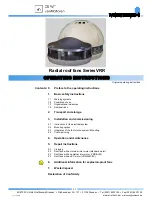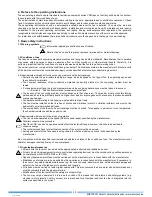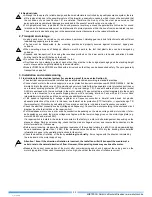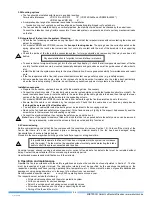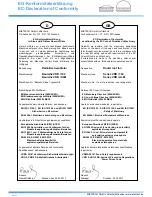
04
MIETZSCH GmbH Lufttechnik Dresden
s
www.mietzsch.de
3.2 Mounting options
The fan should be installed with its axis in a vertical position.
Permissible tolerances:
VRR 160 to VRR 315
10° (VRR160/ALM and VRR200/ALM 90° )
VRR 400 and VRR 500
5°
A comprehensive range of accessories is available for installation:
foundation ring, roof upstand, sound insulation base, foundation plate, hinged roof upstand, etc.
The fan can also be installed directly on vertical pipelines, the stability of which must be checked by the owner/user.
Connect the intake duct using flexible connectors. Connected system components must not exert any mechanical loads
on the fan.
3.3 Integration of the fan into the system / Mounting
• Check the fan for damage sustained during transport. Check that the impeller rotates without contacting the sides and
adjust, if necessary.
For models VRR400 and VRR500, remove the
transport locking device.
The springs must be correctly seated on the
spring plates and the round steel column must not come into contact with the wall of the borehole in the supporting
frame.
Check the inside of the fan and the connected system for foreign objects and remove any that may have been left
behind.
Pay special attention to forgotten tools and leftover materials.
To ensure that no foreign matter can get into the fan and thus destroy it, check that all components upstream of the fan
are fully functional and securely mounted (especially dampers and gate valves as well as guide vanes of elbow ducts,
etc.).
Install the fan into the system according to the project description. Ensure good accessibility for maintenance and repair
work.
If the fan is operated with a free inlet, prevent accidental contact using a safety device (e.g. a safety screen).
Extreme weather conditions may lead to the ingress of small amounts of rainwater into the intake duct, particularly
when the fan is not operating. Therefore, do not locate any sensitive equipment or systems in the intake side.
Installation sequence
Prepare the foundation, upstand, base etc.; affix foam sealing strips, if necessary
Connect the electricity cable. The electricity cable can be routed outside or inside the foundation structure or shaft. If a
sound insulation base is used, route the cable to the motor through the cable glands in the base, then through the lower
section of the fan and through the borehole in the supporting column.
For models VRR400 and VRR500, route the cable from below through the flexible protective hose to the motor.
Ensure that the cable is not abraded by fan components. Check that the cable does not have any sharp bends.
If a hinged base is used, fit a flexible cable.
The insulation of cables laid inside the ducting must be resistant to the conveying medium.
Remove the fan hood and safety screen (upwards), fit the fan and screw it lightly to the support. Subsequently, seal the
screw holes in the lower section with sealing compound.
Connect the electrical cables, then replace the safety screen and the hood.
Note:
Some of the special models are fitted with a lock that has to be opened before the safety screen can be removed.
During reassembly, make sure the screen is firmly mounted and fully functional.
3.4 Commissioning
Before commissioning, check that the fan complies with the conditions of use (see Section 1.2). Cordon off the vicinity of the
fan so that there is no risk of personal injuries or damaging material assets if the fan has been damaged during
transportation or it sucks in foreign bodies.
Proceed in the same way when switching on the fan after a repair or a long downtime.
It is prohibited to operate the fan until it has been integrated into the system in accordance
with the project. The fan must not be operated without contact guards protecting the intake
and/or outlet if they are unconnected and thus free.
Abnormal noises, uneven running and excessive motor current often indicate fan defects that must be remedied without
delay. Contact the manufacturer if this occurs during the warranty period.
Unauthorised measures and modifications void the warranty.
4. Operation and maintenance
Operate the fan in accordance with the safety regulations as well as the conditions of use stipulated in Section 1. The fan
must be inspected at regular intervals. The inspection intervals must be specified by the owner/user depending on the
respective operating conditions (soiling, operating time, temperature, etc.). Account must be taken of possible hazards and
damage occurring during downtime or in the event of a malfunction or an accident.
Recommended inspection interval:
every 5,000 operating hours or once a year.
The inspection must include the following:
All electrical connections and the motor protection system
All fan components for obvious damage
Smooth running as well as bearing noises or rubbing noises
All screwed connections on the motor, support ring and hood
Soiling of the fan and the motor
!
!
!
oi_vrr (11/09)

